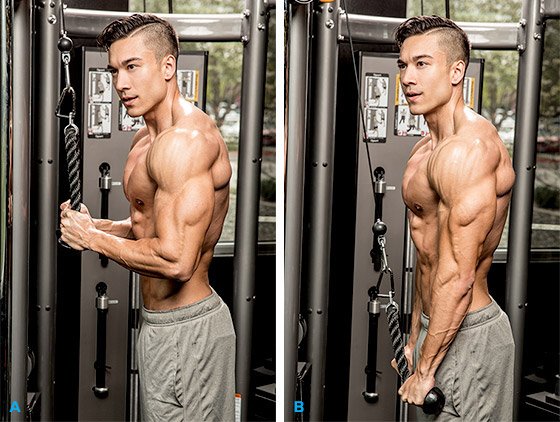Bodybuilding may not be a science but there are definitely a number of truisms. I recall the second law of training: Thou shalt train triceps after chest. The first commandment? Never do legs on a Friday lest you be the slowest guy on the dance floor by Saturday.
As for the push-day workout, the reasoning goes that since your triceps are already somewhat fatigued assisting your pecs in the pressing motions, you might as well finish them off. That's what I discovered in this mother-of-all finishing moves built on a single—yep, one!—triceps exercise that's done only after a heavy session of chest presses.
Be forewarned: The pump you'll experience will become the standard by which all future arm workouts will be measured!
THE 10-MINUTE PUMP
Here, you'll do the rope press-down—this appears to be a fairly ordinary exercise—at the end of your chest routine. What makes this work so exceptionally well is that you combine rest-pause and dropset techniques, going almost nonstop for a full 10 minutes. You take only a 20-second rest between sets and you're right back doing press-downs again. That pace ensures you're only partially recovered before you start your next set.
As lactic acid builds, each set becomes progressively more difficult. As your arms become increasingly pumped, you either start to do fewer reps on successive sets or—when you can't do more than eight reps—you drop the weight one plate. Continue this fast-paced technique for a total of 10 minutes; you may end up doing 18 total sets, but that total number is less important because you are training by feel.

Triceps Pushdown - Rope Attachment
This technique works especially well after a heavy chest workout because the triceps are already fatigued from pressing. I've found that my triceps are often more sore after a chest workout than after a triceps workout.
A chest workout comprising heavy presses from various angles ensures that your arms will already be close to toast as you get started.
Ready to give it a try? Keep these guidelines in mind!
Finishing Move Guidelines
-
Choosing the right starting weight is essential. You want it to be a weight with which you can do no more than about 12 reps with good form.
-
Be wary of working-in with someone who's using a slower pace, which will adversely affect your ability to move fast from one set to the next. Keep an eye on the clock because it's easy to get distracted and rest too long. Once you hit 15 seconds, get back in position so that, boom, you're ready to rock by 20.
-
Again, do as many reps as you can with good form, then take another 20-second rest. As you repeat this work/rest cycle, your arms will quickly fatigue and the number of reps will start to drop from one set to the next. But don't rest any longer; once you can't do more than about eight reps, reduce the weight by a single plate; this will push your reps back up a bit.
-
As your reps start to drop again on successive sets, you can drop the weight one plate at a time when you start doing fewer than eight. Hence, on every set you'll either do fewer reps with the same weight or drop the poundage by a plate.
-
Fatigue levels rise fast as your arms start to swell—that's the whole point. Continue this pattern for a total of 10 minutes. Don't bother counting your total sets—you're working to super-pump your triceps to finish them off at the end of your workout.
-
If you use this technique with a training partner, move back and forth as quickly as possible. When he's done with his set, immediately adjust the pin and do yours.
-
This technique is not meant to replace your normal triceps day but can be done on top of your regular workout. Just make sure you don't retrain triceps within 48 hours of using this intense technique.
